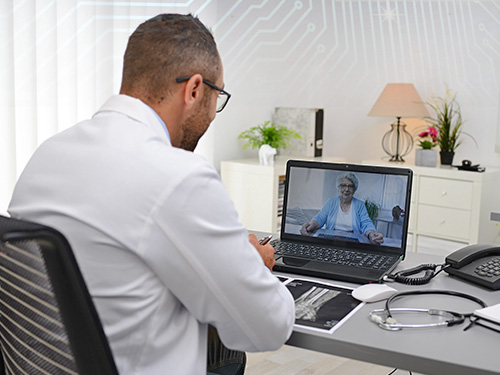3 Ways Telemedicine Makes Healthcare More Effective and Efficient
Quality patient care is the goal of every healthcare provider, but the reality is that many spend up to 60 percent of their time doing administrative tasks rather than delivering care. Doctors, nurses and administrators are all experiencing a time crunch due to steadily increasing management requirements.
Telemedicine technology effectively addresses these issues. By enabling real-time, two-way interactive video consultations between physicians and remote patients, telemedicine can increase staff efficiency and reduce costs while simultaneously improving quality of care, patient satisfaction and clinical outcomes.

Global Market Insights expects telemedicine to become a $130 billion market by 2025, up from $38 billion in 2018.
This growth is largely being driven by the convergence of two trends — an aging population with increased healthcare needs and a dwindling physician population. The Census Bureau projects that 20 percent of the U.S. population — including roughly one-third of all currently active doctors — will be over age 65 by 2030. The Association of American Medical Colleges (AAMC) is projecting a shortage of up to 120,000 physicians by then.
Telemedicine can increase staff efficiency and reduce costs while simultaneously improving quality of care, patient satisfaction and clinical outcomes.
Improved access to care is the most obvious benefit of telemedicine. In rural areas where patients have extremely limited access to specialists, telemedicine enables consultations that would otherwise create significant hardships. Patients don’t have to take off work or travel perhaps hundreds of miles for appointments.
However, telemedicine can improve healthcare operations in these three main areas:
Provider Efficiency
Physicians can save time and improve accuracy by charting the visit during the live video session. With in-person visits, doctors often wait until the end of the day to chart notes for all the day’s appointments. That’s not only time-consuming but can lead to some lapses in details.
Telemedicine appointments also tend to be quicker than in-person visits. One study found that the typical video appointment lasts about 12 minutes, roughly 20 percent less than in-person appointments. Analysts suggest this may be because video appointments tend to be more focused and to-the-point.
Resource Utilization
Telemedicine reduces healthcare costs by lowering the readmission rates of post-acute patients who have been hospitalized and discharged. Researchers suggest that the higher frequency of consultations helps physicians ensure that these patients are following their care plans and using medications properly.
The technology can also support management of chronic diseases. Researchers hypothesize that regular monitoring provides early indications of disease-related changes that can be addressed before they reach a critical stage.
Staff Efficiency
Administrators, managers, receptionists and nursing staffs experience a variety of ancillary benefits from telemedicine. With fewer in-person visits, staff has more time to handle administrative tasks such as patient scheduling, data entry, billing and more. Remote consultations also reduce staff’s exposure to patients with viruses, influenza, measles and other contagious illnesses.
Telemedicine can also improve operations by reducing no-shows, which create scheduling problems and lost revenue. At the same time, the technology can boost revenues by allowing practices to take on new patients who can’t get quick access to their doctors or just like the convenience of video appointments.
Technology Requirements
Telemedicine requires a high-performance, highly available Internet connection with robust security to protect sensitive patient data. GDS meets these requirements with our private, secure software-defined WAN solution with elastic bandwidth and multiple “last mile” options. The solution is fully managed 24x7, with one number to call for support and one simple bill for all services.
Technology Infrastructure Experience
GDS also has broad experience with the technology infrastructure that power modern medical practices. Let us help you implement a telemedicine solution that creates operational efficiencies and cost benefits while enhancing patient care.
Contact Global Data Systems Now >

